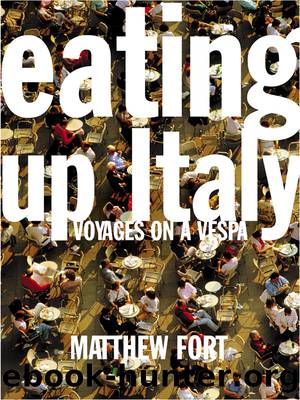Eating Up Italy by Matthew Fort

Author:Matthew Fort
Language: eng
Format: epub
Publisher: HarperCollins Publishers
Published: 2004-01-15T00:00:00+00:00
According to André Gide, Ascoli Piceno is the most beautiful town in Italy. I wouldnât have gone that far, but it certainly had great charm and a quiet sense of past wealth. Quite a long way in the past, in fact. Ascoli grew rich under the Romans because it controlled the Via Flaminia Salaria, the old salt road between the coast and Rome, and the street grid has hardly changed since. Most of the handsomest buildings are the product of the thirteenth century, the cityâs most glorious period. After centuries of unbiddable independence, decline set in with the coming of papal rule in the fifteenth century.
Now, however, Ascoli seemed to be in the ascendant again, partly because of the agricultural richness of the hinterland, and partly because of the centralisation of local industry along the River Tronto. Walking round Ascoli, I came across bits of Roman, bits of Longobard, bits of every century between the thirteenth and the twentieth, if you counted the industrial belt. The sight of a youth shooting up in the reconstructed Roman guardhouse on the bridge over the Torrente Castellano by the Castello Malatesta seemed to telescope past and present. Even in Sulmona, the sense of history was relatively one-, or possibly two-, dimensional by comparison.
Italian towns appear to have a happy knack of accommodating the demands of the twenty-first century without wholesale destruction of what went before. Tourists are carefully corralled into designated areas, as if they are animals of rather uncertain temperament, to be kept docile by culture, large quantities of ice cream and the civilising qualities of the cafés.
The Caffè Meletti in the Piazza del Popolo could have been the model for the Café Momus in Pucciniâs La Bohème. This was the palace that liquorice built. Aniseed grows plentifully in the area, and found its way into local consumption through a liqueur incorporating it. Indeed, the legend that runs across the pink front of the building reads âAnisetti Melettiâ. The caféâs recent history had been chequered, and it had to be rescued from genteel decay by a local bank, but, restored, revived and revitalised, it would stand out in Rome, Paris, Milan, Turin, New York, London, anywhere. It was suave, but not chic. It was scenic, but did not pose. It had a tremendous confidence, but it didnât swagger. It took up one quarter of one side of the Piazza del Popolo, a side which it shared with the magnificent Palazzo dei Capitani, but was not diminished by it.
The floor was well-polished wood. The ceiling high above was decorated in a fairly loose Art Deco pattern in green on a mottled yellow background. At one end was a colossal mirror, at the other a bar displaying panini and other things to eat. There was a second bar surmounted by bottles running down part of the wall opposite the entrance, which was situated right in the centre of the long front. Half the floor space was empty, and the other half full of tables with gracefully curving bentwood chairs.
Download
This site does not store any files on its server. We only index and link to content provided by other sites. Please contact the content providers to delete copyright contents if any and email us, we'll remove relevant links or contents immediately.
Spell It Out by David Crystal(35358)
Underground: A Human History of the Worlds Beneath Our Feet by Will Hunt(11264)
A Year in the Merde by Stephen Clarke(4663)
Venice by Jan Morris(2055)
Claridge's: The Cookbook by Nail Martyn & Erickson Meredith(1964)
My Paris Kitchen: Recipes and Stories by Lebovitz David(1894)
A TIME OF GIFTS by Patrick Leigh Fermor(1851)
The Plantagenets by Dan Jones(1617)
Welcome to the Goddamn Ice Cube by Blair Braverman(1603)
Bang Poland: How To Make Love With Polish Girls In Poland by Roosh V(1590)
Top 10 Prague (EYEWITNESS TOP 10 TRAVEL GUIDES) by DK(1569)
From Russia with Lunch by David Smiedt(1552)
The Finnish Way by Katja Pantzar(1537)
The Isle of Mull by Terry Marsh(1521)
A TIME TO KEEP SILENCE by Patrick Leigh Fermor(1500)
Rick Steves London 2018 by Rick Steves & Gene Openshaw(1494)
A Taste of Paris by David Downie(1492)
Merde in Europe by Stephen Clarke(1436)
Insight Guides Experience Tokyo by Insight Guides(1420)
